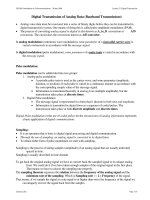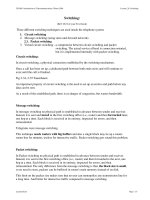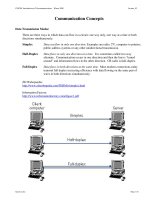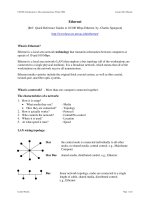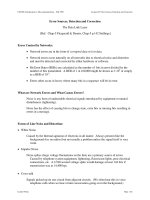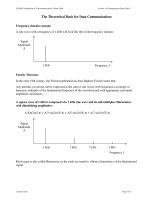Tài liệu lecture 08a: Ethernet pdf
Bạn đang xem bản rút gọn của tài liệu. Xem và tải ngay bản đầy đủ của tài liệu tại đây (75.14 KB, 12 trang )
CSN200 Introduction to Telecommunications, Winter 2000 Lecture-08a Ethernet
Ethernet
[Ref: Quick Reference Guides to 10/100 Mbps Ethernet, by- Charles Spurgeon]
/>
What is Ethernet?
Ethernet is a local area network technology that transmits information between computers at
speeds of 10 and 100 Mbps.
Ethernet is a local area network (LAN) that employs a bus topology (all of the workstations are
connected to a single physical medium). It is a broadcast network, which means that all of the
workstations on the network receive all transmissions.
Ethernet media varieties include the original thick coaxial system, as well as thin coaxial,
twisted-pair, and fiber optic systems.
What is a network? - More than one computer connected together.
The characteristics of a network:
1. How it is setup?
• What media they use? - Media
• How they are connected? - Topology
2. How it actually works? - Protocol
3. Who controls the network? - Central/No control
4. Where it is used? - Location
5. At what speed it runs? - Speed
LAN wiring topology:
Star the central node is connected individually to all other
nodes, no shared media, central control. e.g., Mainframe
Computer
Star Bus shared media, distributed control. e.g., Ethernet
Bus linear network topology, nodes are connected to a single
length of cable, shared media, distributed control.
e.g., Ethernet
lecture 08a.doc Page 1 (12)
CSN200 Introduction to Telecommunications, Winter 2000 Lecture-08a Ethernet
Ring a closed-loop network topology, shared media,
distributed control, unidirectional.
e.g., Token Ring
Mesh has at least two pathways to each node.
1. How Ethernet is setup?
• Ethernet Media - Copper cables and Fiber Optic cables
• Copper cables:
• Coaxial - Thick/Thin
• Twisted pair - Shielded/Unshielded
• Different Ethernet Standards based on the speed and cable type:
• 10BaseT (Unshielded Twisted Pair)
• 10Base2 (Thinnet, Thin Ethernet)
• 10Base5 (Thicknet, Standard Ethernet)
• 10BaseFL (Fiber Optic Cable)
• 100BaseT4 (Telephone Grade, 4 pair)
• 100BaseTX (Data Grade, 2 pair)
• 100BaseFX (Fiber OpticLink Segment, 2 strands of fiber cable)
• 100VG-AnyLAN (Voice Grade 3UTP, Using "Demand Priority" mechanism
allows TokenRing frames 802.12)
• Ethernet Topologies (Layout)
• Logical Topologies
• Bus
• Physical Topologies
• Linear Bus
• Star Bus
2. How Ethernet actually works/What set of rules?
• Ethernet uses a media access control (MAC) based on CSMA/CD (Collision Sensing
Multiple Access/Carrier Detect)
• Steps which a computer takes to talk to another computer using Ethernet:
lecture 08a.doc Page 2 (12)
CSN200 Introduction to Telecommunications, Winter 2000 Lecture-08a Ethernet
• Listens.
• Sends packet with address of destinations computer in the header.
• Receiving computers:
• If the packets has it's address, it picks up the packet.
• If packet does not have it's address, it is ignored.
• Retransmits if a collision occurs
• Both machines wait a random period of time and retransmit.
3. Who controls the Ethernet network?
• No central control.
• Each node/station is independent of all other stations while connected on a shared bus.
4. Where it is used?
• Local area network.
5. At what speed it runs?
• 10 Mega bits/sec or 1.25 Mega Bytes/sec.
• 100 Mega bits/sec or 12.5 Mega Bytes/sec.
Development of Ethernet Standards:
Ethernet was invented at the Xerox Palo Alto Research Center in the 1970s by Dr. Robert M.
Metcalfe. It was designed to support research on the "office of the future," which included one of
the world's first personal workstations, the Xerox Alto.
The first Ethernet system ran at approximately 3-Mbps and was known as "experimental
Ethernet."
Formal specifications for Ethernet were published in 1980 by a multi-vendor consortium that
created the DEC-Intel-Xerox (DIX) standard. This effort turned the experimental Ethernet into
an open, production-quality Ethernet system that operates at 10-Mbps. Ethernet technology was
then adopted for standardization by the LAN standards committee of the Institute of Electrical
and Electronics Engineers (IEEE 802).
The IEEE standard was first published in 1985, with the formal title of "IEEE 802.3 Carrier
Sense Multiple Access with Collision Detection (CSMA/CD) Access Method and Physical Layer
Specifications." The IEEE standard has since been adopted by the International Organization for
Standardization (ISO), which makes it a worldwide networking standard.
The IEEE standard provides an "Ethernet like" system based on the original DIX Ethernet
technology. All Ethernet equipment since 1985 is built according to the IEEE 802.3 standard,
which is pronounced "eight oh two dot three." To be absolutely accurate, then, we should refer to
Ethernet equipment as "IEEE 802.3 CSMA/CD" technology. However, most of the world still
knows it by the original name of Ethernet, and that's what we'll call it as well.
The 802.3 standard is periodically updated to include new technology. Since 1985 the standard
has grown to include new media systems for 10-Mbps Ethernet (e.g. twisted-pair media), as well
lecture 08a.doc Page 3 (12)
CSN200 Introduction to Telecommunications, Winter 2000 Lecture-08a Ethernet
as the latest set of specifications for 100-Mbps Fast Ethernet.
Invention of Ethernet:
Metcalfe realized that he could improve on the Aloha system of arbitrating access to a shared
communications channel. He developed a new system that included a mechanism that detects
when a collision occurs (collision detect). The system also includes "listen before talk," in which
stations listen for activity (carrier sense) before transmitting, and supports access to a shared
channel by multiple stations (multiple access). Put all these components together, and you can
see why the Ethernet channel access protocol is called Carrier Sense Multiple Access with
Collision Detect (CSMA/CD). Metcalfe also developed a much more sophisticated backoff
algorithm, which, in combination with the CSMA/CD protocol, allows the Ethernet system to
function all the way up to 100 percent load.
In late 1972, Metcalfe and his Xerox PARC colleagues developed the first experimental Ethernet
system to interconnect the Xerox Alto. The Alto was a personal workstation with a graphical
user interface, and experimental Ethernet was used to link Altos to one another, and to servers
and laser printers. The signal clock for the experimental Ethernet interfaces was derived from the
Alto's system clock, which resulted in a data transmission rate on the experimental Ethernet of
2.94 Mbps.
Why is it called Ethernet?
Metcalfe's first experimental net was called the "Alto Aloha Network." In 1973 Metcalfe
changed the name to "Ethernet," to make it clear that the system could support any computer,
and not just Altos, and to point out that his new network mechanisms had evolved well beyond
the Aloha system. He chose to base the name on the word "ether" as a way of describing an
essential feature of the system: the physical medium (cable) carries bits to all stations, much the
same way that the old "luminiferous ether" was once thought to propagate electromagnetic waves
through space. Physicists Michelson and Morley disproved the existence of the ether in 1887, but
Metcalfe decided that it was a good name for his new network system that carried signals to all
computers. Thus, Ethernet was born.
Elements of the Ethernet System:
The Ethernet system consists of three basic elements:
1. the physical medium used to carry Ethernet signals between computers,
2. a set of medium access control rules embedded in each Ethernet interface that allow multiple
computers to fairly arbitrate access to the shared Ethernet channel, and
3. an Ethernet frame that consists of a standardized set of bits used to carry data over the
system.
lecture 08a.doc Page 4 (12)
CSN200 Introduction to Telecommunications, Winter 2000 Lecture-08a Ethernet
Operation of Ethernet
Each Ethernet-equipped computer, also known as a station, operates independently of all other
stations on the network: there is no central controller. All stations attached to an Ethernet are
connected to a shared signaling system, also called the medium. Ethernet signals are transmitted
serially, one bit at a time, over the shared signal channel to every attached station. To send data a
station first listens to the channel, and when the channel is idle the station transmits its data in the
form of an Ethernet frame, or packet.
After each frame transmission, all stations on the network must contend equally for the next
frame transmission opportunity. This ensures that access to the network channel is fair, and that
no single station can lock out the other stations. Access to the shared channel is determined by
the medium access control (MAC) mechanism embedded in the Ethernet interface located in
each station. The medium access control mechanism is based on a system called Carrier Sense
Multiple Access with Collision Detection (CSMA/CD).
The CSMA/CD Protocol:
The CSMA/CD protocol functions somewhat like a dinner party in a dark room. Everyone
around the table must listen for a period of quiet before speaking (Carrier Sense). Once a space
occurs everyone has an equal chance to say something (Multiple Access). If two people start
talking at the same instant they detect that fact, and quit speaking (Collision Detection.)
To translate this into Ethernet terms, each interface must wait until there is no signal on the
channel, then it can begin transmitting. If some other interface is transmitting there will be a
signal on the channel, which is called carrier. All other interfaces must wait until carrier ceases
before trying to transmit, and this process is called Carrier Sense.
All Ethernet interfaces are equal in their ability to send frames onto the network. No one gets a
higher priority than anyone else, and democracy reigns. This is what is meant by Multiple
Access. Since signals take a finite time to travel from one end of an Ethernet system to the other,
the first bits of a transmitted frame do not reach all parts of the network simultaneously.
Therefore, it's possible for two interfaces to sense that the network is idle and to start
transmitting their frames simultaneously. When this happens, the Ethernet system has a way to
sense the "collision" of signals and to stop the transmission and resend the frames. This is called
Collision Detect.
The CSMA/CD protocol is designed to provide fair access to the shared channel so that all
stations get a chance to use the network. After every packet transmission all stations use the
CSMA/CD protocol to determine which station gets to use the Ethernet channel next.
lecture 08a.doc Page 5 (12)
